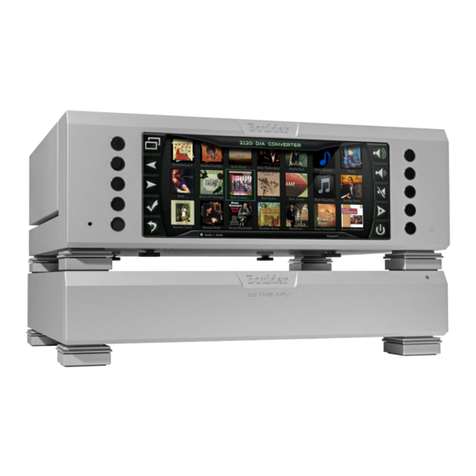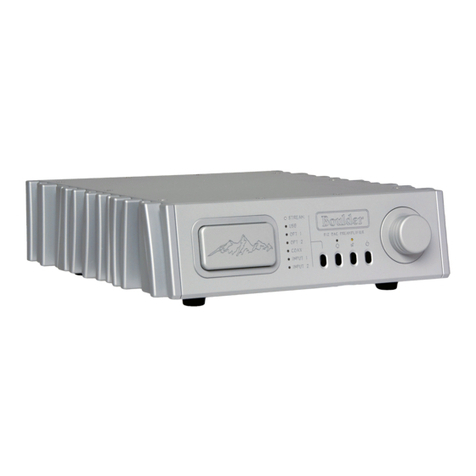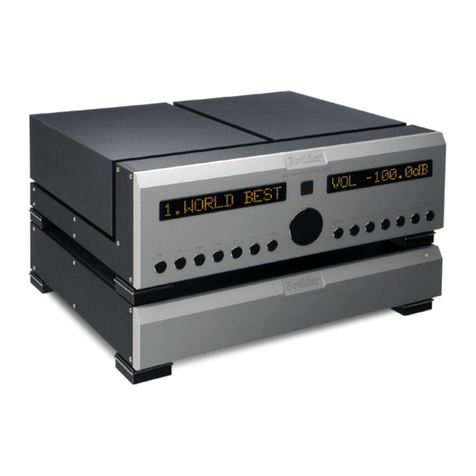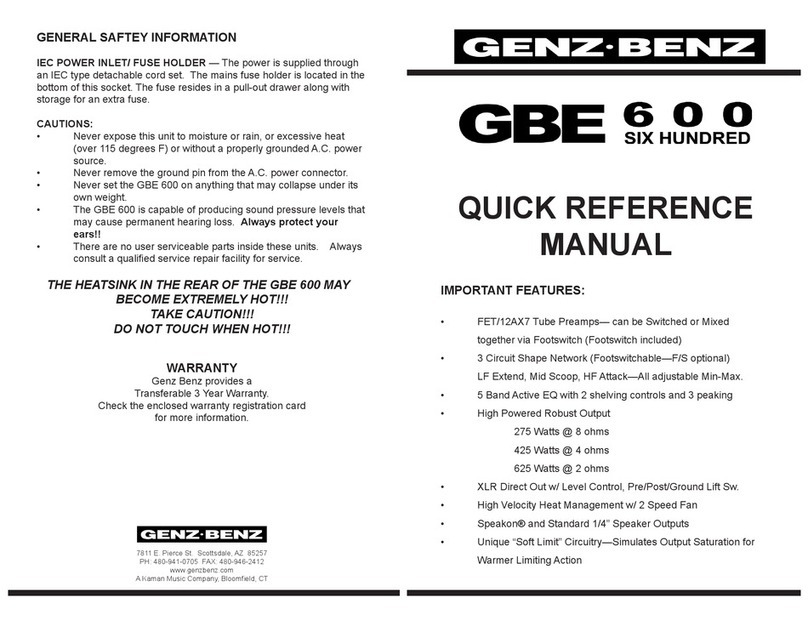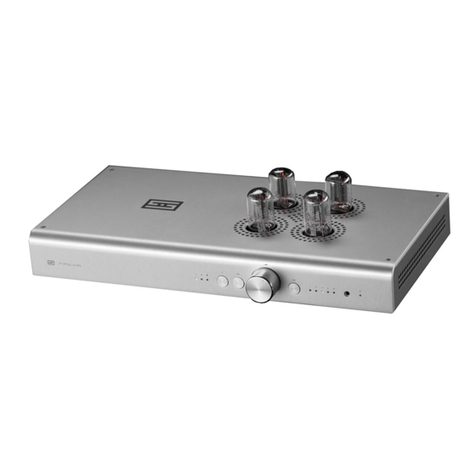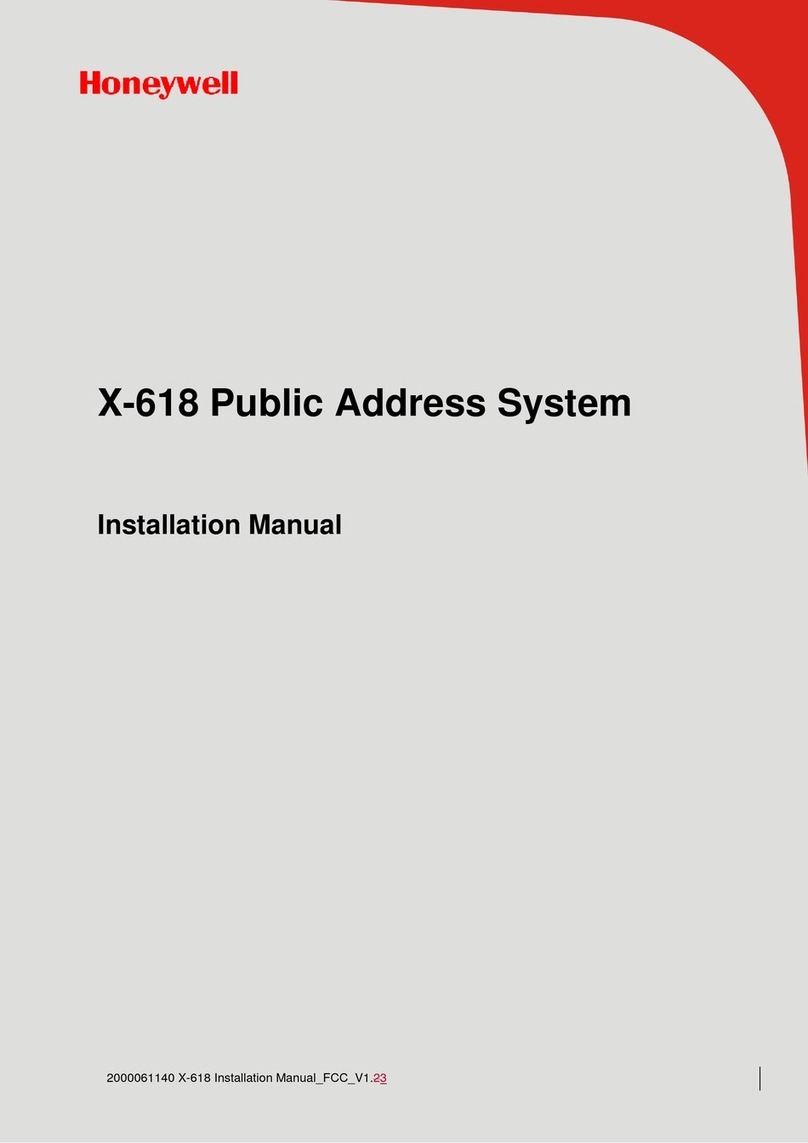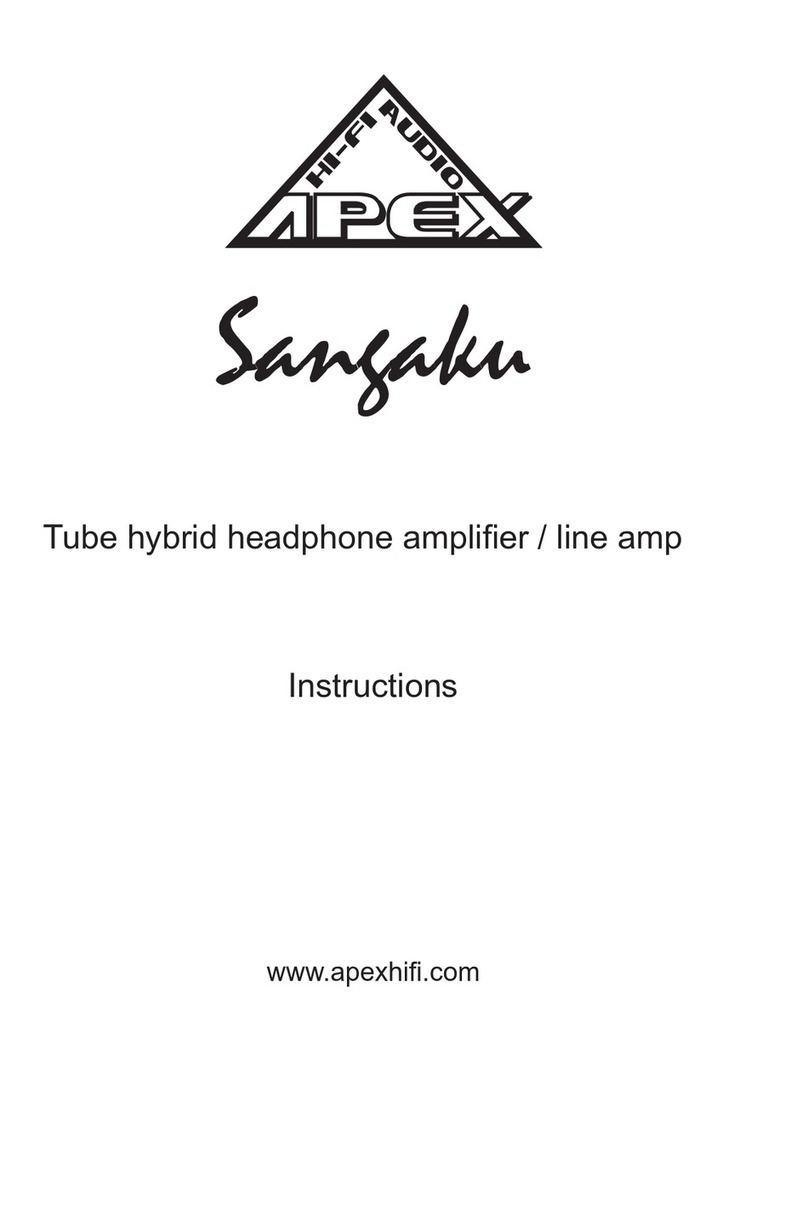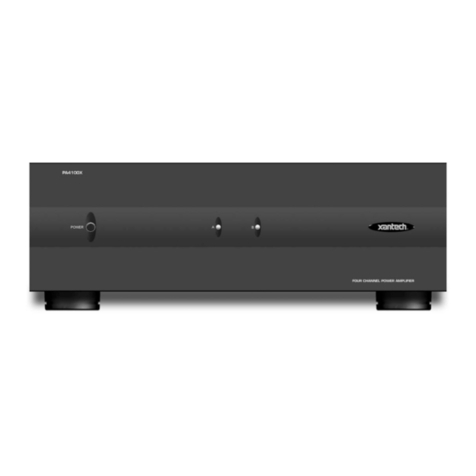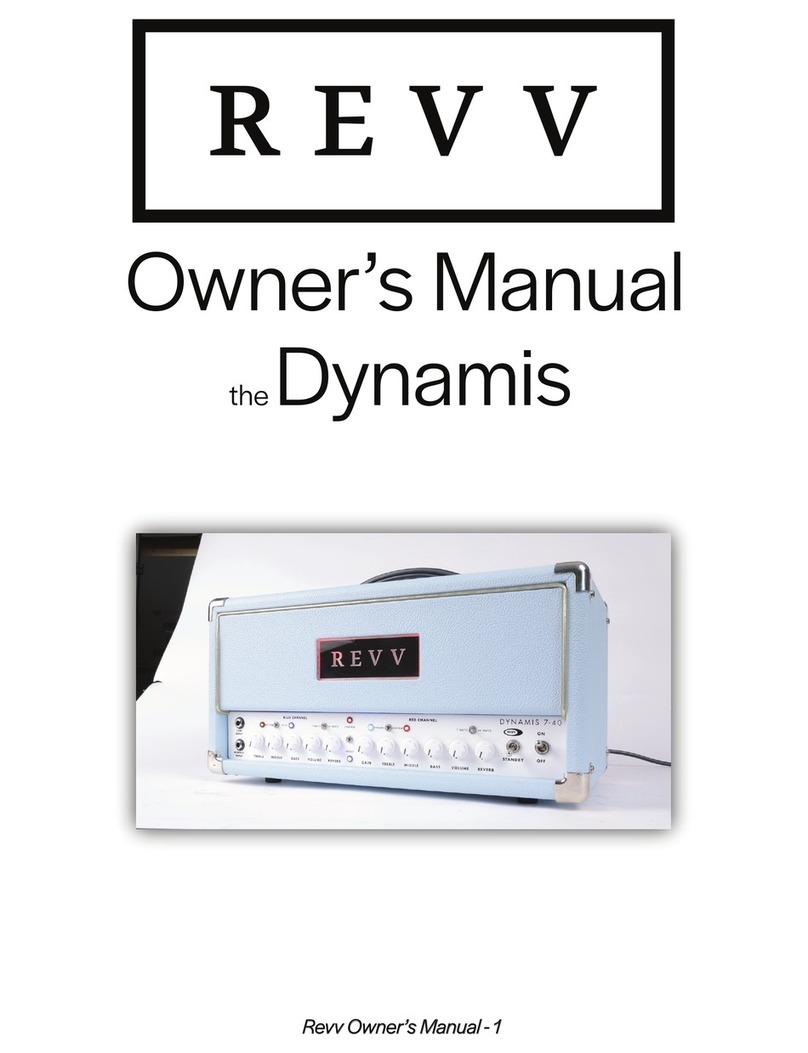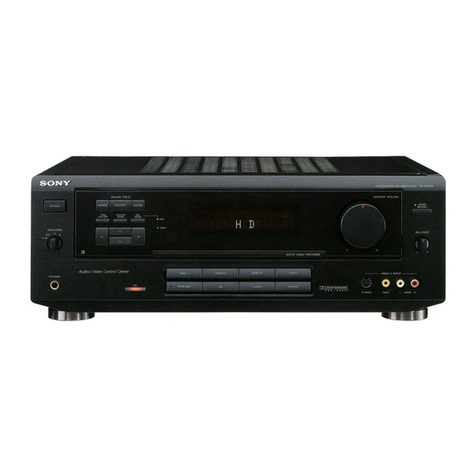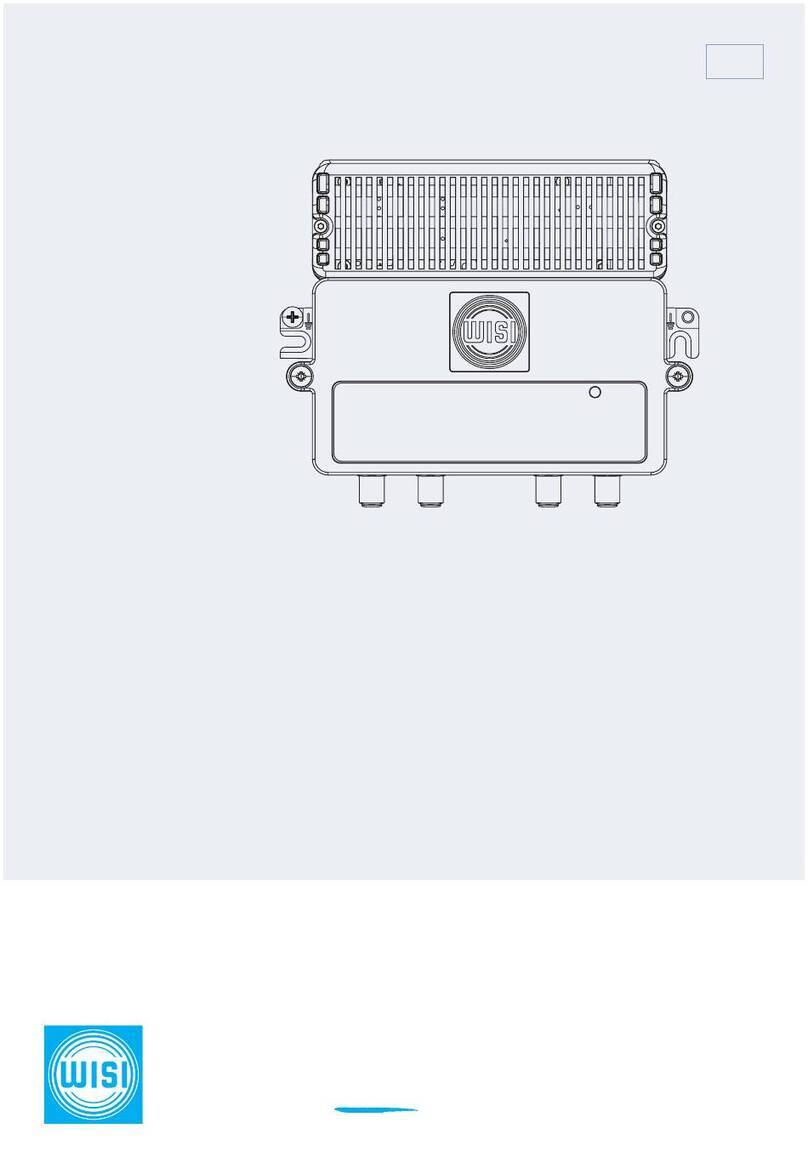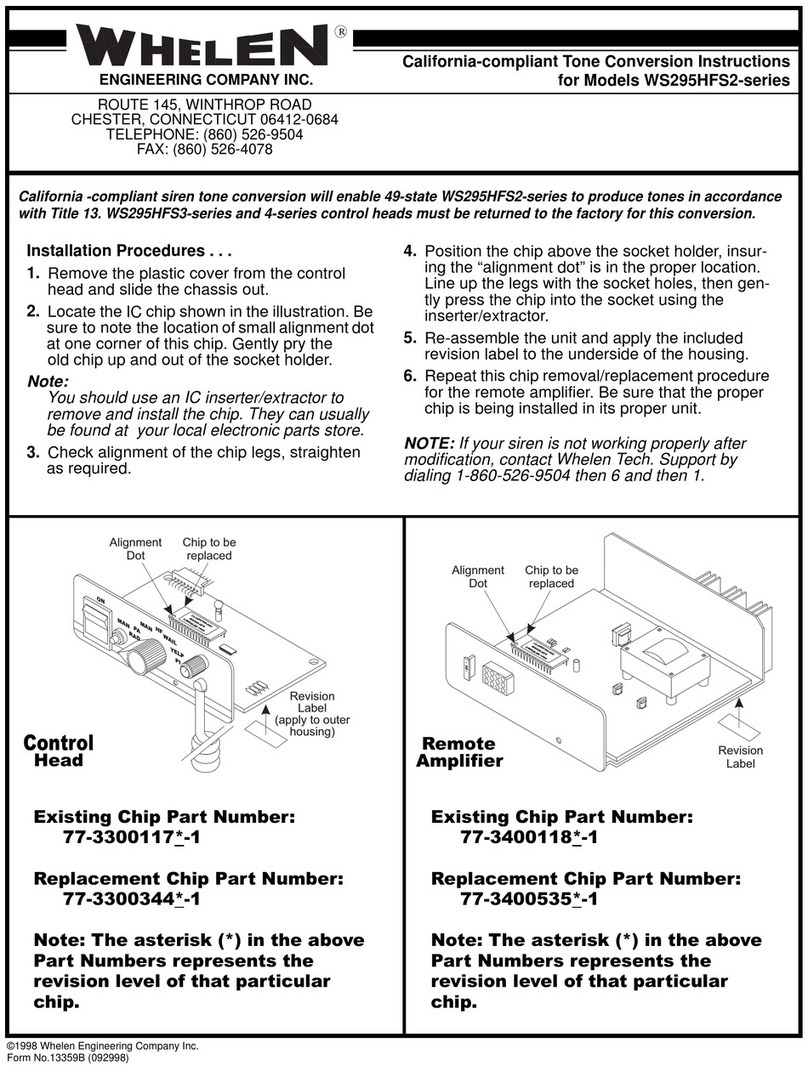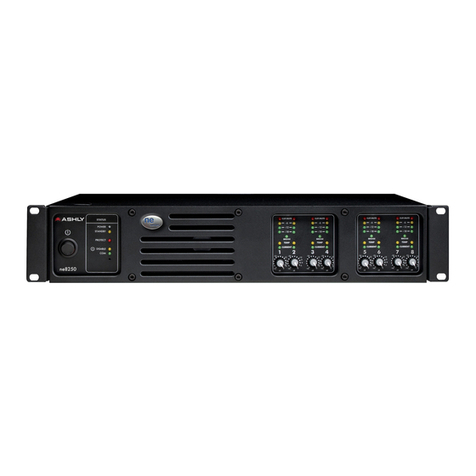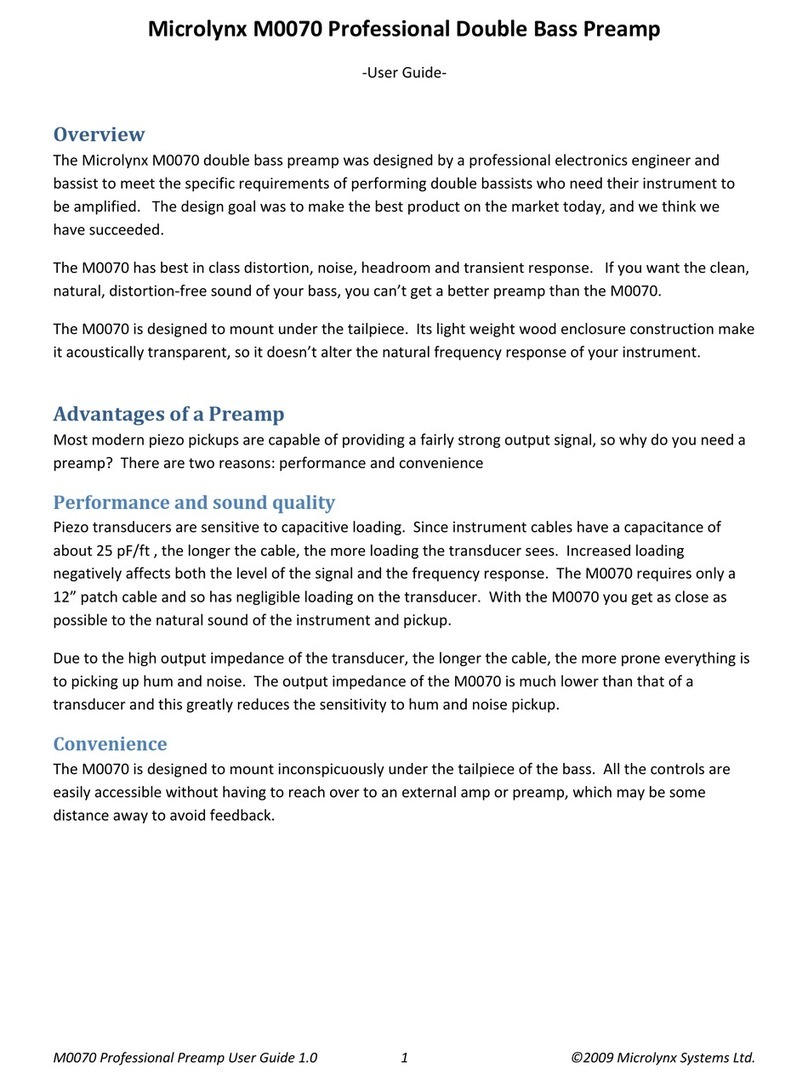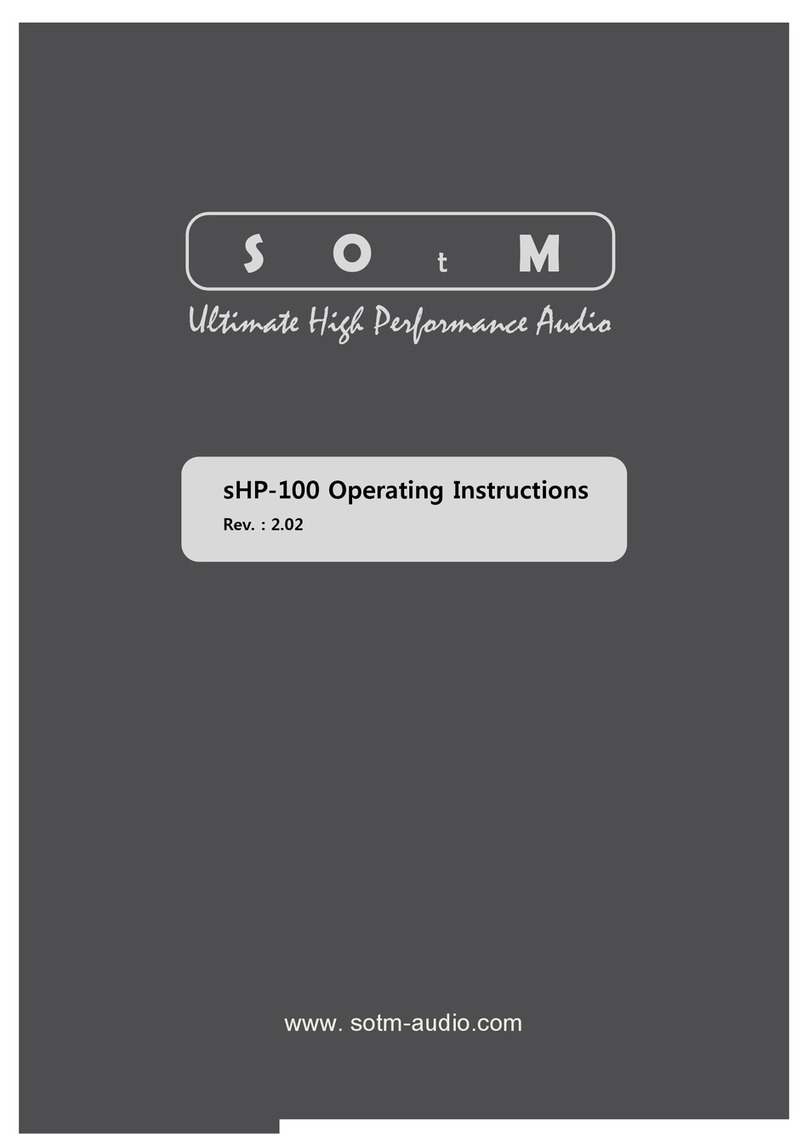Boulder 861 User manual

i
255 South Taylor Avenue Louisville, Co 80027 U.S.A Tel: 303-495-2267 E-mail: sales@boulderamp.com Web: www.boulderamp.com
Boulder Ampliers, Inc.
255 S. Taylor Avenue
Louisville, CO 80027
(303) 495-2267
www.boulderamp.com
BoulderAmpliersInc
@boulderampliers
@BoulderAmps
861 Stereo Power Amplier

1-1
About Boulder Ampliers, Inc.
Boulder was founded in 1984 and is the last high-performance audio manufacturer operating
in North America to still perform all of its own design, engineering and manufacturing in-
house. While this form of production may be more costly than outsourcing, the resulting quality
control and reliability of the nished products are never compromised.
In 2016, Boulder moved into a new, purpose-built production facility to increase manufacturing
eciency and oer space for expansion to meet the needs of future growth.

2-2
Congratulations and thank you for selecting the Boulder 861 Stereo Power Amplier for your
high-performance sound system. We are certain it will provide you with many years of listening
pleasure.
e 861 represents the concerted eorts of numerous Boulder designers, engineers, and
technicians working to bring you the best audio playback components in the world. Please take a
few minutes to read through this instruction manual prior to using your 861. is will help you
understand the many functions and capabilities of the device. It will also allow you to maximize
the convenience and performance for which it was engineered.
Your Boulder 861 has undergone extensive laboratory tests for safety, functionality and technical
excellence. In addition, it has been individually subjected to rigorous listening trials in our
sound room utilizing a wide range of musical material. No product ever leaves our factory until
we are totally satised that it achieves its full potential.

2-3
Table of Contents
About - - - - - - - - - - - - - - - - - - - - - - - - 1-1
ank You - - - - - - - - - - - - - - - - - - - - - - 2-2
Introduction - - - - - - - - - - - - - - - - - - - - - - 3-6
Placement of the 861 Stereo Power Amplier 3-6
Connections - - - - - - - - - - - - - - - - - - - - - - 3-7
Connecting to a Network 3-7
Connecting to a Balanced Source 3-7
Connecting to an Unbalanced Analog Source 3-8
Connecting to the AC Mains Outlet 3-9
Connecting Your Loudspeakers 3-10
Operation- - - - - - - - - - - - - - - - - - - - - - 3-11
Powering Up 3-11
Input DC Oset Voltage Detection 4-12
Clip Detection 4-12
ermal Protection 4-12
Maintenance 4-13
Errors Requiring Boulder Dealer Service4-13
Operational Errors 4-13

2-4
Programming - - - - - - - - - - - - - - - - - - - - 4-14
HTML Programming 4-14
Appendix - - - - - - - - - - - - - - - - - - - - - - 5-15
Technical Specications 5-15
Weights and Dimensions 5-16
861 Stereo Power Amplier Dimensions 5-17
Troubleshooting 5-18
No Power Indication 5-18
Power Indication but No Sound 5-18
Notes: 5-19

3-5
Placement of the 861 Stereo Power Amplier
Your Boulder 861 Stereo Power Amplier is designed to reduce interference from external
magnetic and radio elds (RF). While placement is not critical, known magnetic elds should be
avoided.
e 861 Stereo Power Amplier will generate some heat. erefore, it should be located in an
area with ample air circulation. Specically, be certain that the heat sinks are unobstructed by
objects that could potentially block airow. Do not place the amplier on deep carpet and be
sure that the amplier has a minimum of 3 inches (8 cm) of free airspace on all sides.
You may want to have access to the rear panel for cable changes. Although input cables can be as
long as necessary, it is suggested that speaker cables be as short as possible.

3-6
Connecting to a Network
In order for the 861 to download soware updates as necessary, it will need to be connected to
a network with an active Internet connection. Connect a network cable between the 861 and a
network router or switch. Use the Ethernet connector on the rear panel of the 861.
Connecting to a Balanced Source
To fully realize the sonic potential of your 861 Stereo Power Amplier, always use balanced
connections. Balanced cables minimize interference from magnetic and RF sources.
Connect the cables from your source or preamplier outputs to the input connections provided
on the rear panel of the 861.
Input

3-7
Connecting to an Unbalanced Analog Source
Although the inputs and outputs are all of the 3-pin XLR type, an unbalanced source can easily
be accommodated by using an unbalanced to balanced cable. is cable has an RCA phono-type
connector on the source end and a 3-pin XLR connector for the input/output on the 861 end.
e negative input (pin 3) should be wired to ground only at the RCA phono connector. is
brings the inverted input reference of the 861 to the unbalanced source ground, thus reducing
ground loops.
Another option for connecting unbalanced sources is the Boulder ABL2 input adapter. It
converts a balanced input into an RCA phono input at the rear of the 861. Like the above cable,
the negative input of the 861 is connected to the ground of the RCA phono. However, this
negative side will then share the shield wire with the chassis ground and will not have the best
hum rejection.

3-8
Connecting to the AC Mains Outlet
Your 861 Stereo Power Amplier is supplied with a mains power cable suitable for the location
where it was purchased. It is constructed of large enough wire gauge and a plug appropriate for
your AC line voltage. Do not substitute another power cable.
Exact voltage and frequency compatibility is stated in the specications section. See page 5-1.
Once the 861 Stereo Power Amplier is connected to a live mains outlet and the rear panel
switch is moved to the “On” position, the LED on the front panel will illuminate red for a
short time. During this time the 861 is booting up. e LED will then pulse white on and o,
indicating that the supervising microprocessor is powered up and the amp is ready to be turned
on using the front panel Standby button.

3-9
Connecting Your Loudspeakers
Do not use a wrench or any other type of tool on the output terminal binding posts. Tighten
these connectors by hand only.
WARNING: is is a high-powered amplier! ere is high voltage potential at the
terminals when driven. Connections should only be made with the AC mains disconnected!
Select speaker cable spade terminals that will accept .250-inch (6 mm) diameter binding posts.
Note: ere is no provision for the use of banana plugs. Banana plugs are proven to lose spring
tension and come loose over time, increasing contact resistance and distortion. We also do not
recommend the use of banana plugs at the speaker end for these reasons.
Outputs

3-10
Powering Up
With all connections made, you are ready to listen to your Boulder 861 Stereo Power Amplier.
To turn the amplier on, turn the rear panel Master AC Switch to the ON position. e
amplier will go through a turn-on sequence, during which time the power LED will illuminate
red.
Aer about 20 seconds the LED will then slowly pulse white on and o, indicating that the
supervising microprocessor is powered up. At this time, press the front panel button to bring the
unit out of Standby mode.
Because of the large inrush currents associated with the large toroidal transformer, power relays
are used to turn on the amplier. ese are under control of the supervising ARM processor.
During the power up sequence, you will hear two sets of two relay clicks, separated by intervals
of two seconds.
Once powered up, the front panel LED will steadily glow white to indicate normal operation.
To turn the amplier o, press the Standby button again. e indicator will then slowly and
continuously change from white, to dark, and back to white. is indicates that the amplier is
in Standby mode.
NOTE: Because the 861 greatly reduces power consumption when in Standby mode, it is only
necessary to place the amplier in Standby when not in use. You do not need to turn the 861 o via
the Master AC Switch on the rear panel. e 861 was designed for years of operation in this manner
and no damage to the unit will occur.

4-11
Input DC Oset Voltage Detection
e Boulder 861 is a direct-coupled power amplier with a servo for zeroing out DC voltage
oset coming from the preamplier or other sources connected to the amplier’s input.
If the DC at the inputs is sucient to cause potentially damaging voltage at the output terminals,
a protection circuit will mute the amplier’s output by electronically disconnecting the
loudspeakers. e front panel LED will also turn red. is condition will continue until the
source of DC is corrected or removed.
If the indicator remains red, it is recommended that the user correct the DC oset of the source
device before continuing.
Clip Detection
Clipping of the waveform results when any amplier is driven beyond it’s rated power. A clip
detection circuit is included for protection in the 861 Stereo Power Amplier.
e front panel LED will indicate clipping by momentarily turning from white to red. Both
voltage and current modes of clipping are detected, although it is generally only voltage clipping
that occurs.
ermal Protection
A thermal protection circuit prevents high operating temperatures that are unpleasant to the
touch and potentially harmful to the amplier. A thermal cutout circuit will mute the amplier
when the transistor cases reach 70°C, and the front panel LED will turn red. If this happens, the
output level of the system should be reduced and more ventilation should be provided for the
amplier. Once the amplier temperature cools to 60°C operation may resume.

4-12
Maintenance
No routine maintenance is required for the 861 Stereo Power Amplier. However, to keep
operating temperatures at a minimum, be sure that the heat sinks are not obstructed and remove
any dust buildup that may occur.
Errors Requiring Boulder Dealer Service
If the 861 Stereo Power Amplier will not turn on and the front panel LED blinks red, an error
requiring dealer service has occurred. e indicator may ash red in a specic sequence to
dene its error code for an authorized Boulder technician. If you are experiencing this problem
with your 861, contact your Boulder dealer immediately.
Operational Errors
At times the 861’s front panel LED may ash red but continue operating normally. is is an
Operational Error and indicates that there is a fault somewhere else in the system or in the use of
the amplier.
Conditions that will be indicated as Operational Errors may include:
• DC oset at the input of the amplier (from a source or preamplier)
• ermal limit or safe operating temperature of the amplier exceeded
• Clipping of the output signal

4-13
HTML Programming
ough it is not necessary to use any of the HTML programming functions, you may nd them
helpful in setting up and personalizing your 861.
All HTML programming is accomplished by accessing the 861 HTML page while the unit is
powered up and connected to a live computer network. Once the page is accessed, the various
programming functions can be viewed, changed, and saved.
To access the 861’s HTML page, you will need a computer that is connected to the same network
as the 861 to enter the 861’s network address into a web browser.
To nd the 861’s network address, go into settings on the Boulder Controller App, then press the
System Settings button in the Settings menu, followed by the Network Settings button. You will
see a list of information about the 861, including:
MAC Address:
Network Address:
SSID: BoulderAmpliers-(serial number)
Network Address: If the 861 is attached to an active network, the network address or IP address
of the unit will be indicated here. is number should be entered in the address bar of a web
browser to access the 861’s HTML programming page. e HTML page will then load onto your
browser.

5-14
Technical Specications
Continuous Power, 8 Ohms 50W
Peak Power, 8 Ohms 75W
Continuous Power, 4 Ohms 90W
Peak Power, 4 Ohms 110W
Peak Power, 2 Ohms 200W
Balanced Analog Inputs 1 Pair of Balanced 3 pin XLR
Outputs .25" (6 mm) Binding Posts
Distortion, THD 0.01%
Equivalent Input Noise (EIN), 20 kHz 2.6 μV
Input Impedance 100k Ω Balanced
Frequency Response, 20 Hz to 20 kHz +0.00, -0.04 dB
Frequency Response, -3 dB 0.015 Hz & 150 kHz
Maximum Analog Gain 26.0 dB
Power Requirements (Country Specic congured) 100V, 120V, 240V 50-60Hz
Power Consumption 550W Max
Note: All measurements taken at 120V

5-15
Weights and Dimensions
861 Stereo Power Amplier Chassis: 12” W x 12” D x 3.25” H
(21.5 lbs)
30.5 cm W x 30.5 cm D x 8.3 cm H
(9.75 kg)
Shipping: 24” W x 23” D x 14” H
(25 lbs)
61 cm W x 59 cm H x 36 cm H
(11.34 kg)

5-16
861 Stereo Power Amplier Dimensions
12.000
2.000
.910
8.000
12.000
13.541
.379 1.625 8.900 1.475
3.504

5-17
Troubleshooting
No Power Indication
Master AC Power Switch on
rear panel is not ON
Turn on Master AC Power
Switch
861 is not plugged in Connect power cord to AC
mains outlet
861 boot-up is locked Turn o unit from Master AC
switch and back on
Home circuit breaker is
tripped
Reset home circuit breaker
Low line voltage Have line voltage checked
Defective power cable Have power cable tested or
replaced
Power Indication but No
Sound
No signal from one channel Check cables, connections,
swap cables and see if the
problem follows
No signal out of 861 Check interconnect and
speaker cables, make sure it is
out of standby and power LED
is Solid White

5-18
Notes:
Table of contents
Other Boulder Amplifier manuals
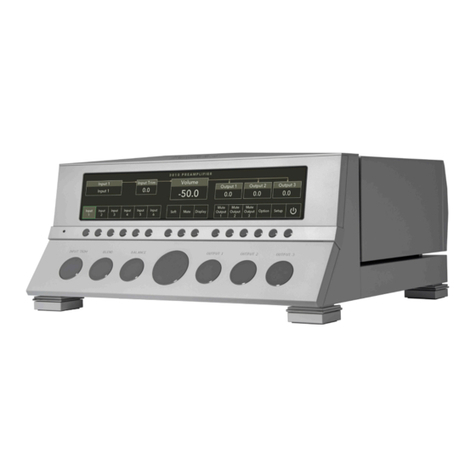
Boulder
Boulder 3010 User manual
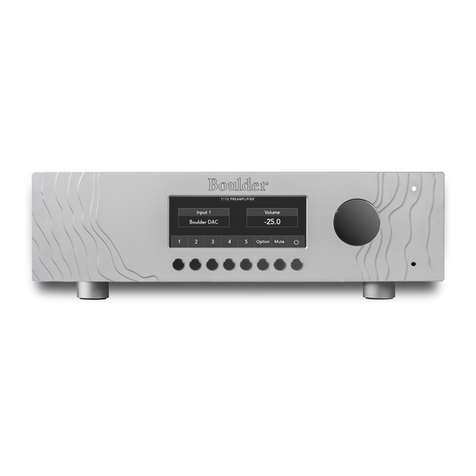
Boulder
Boulder 1110 User manual
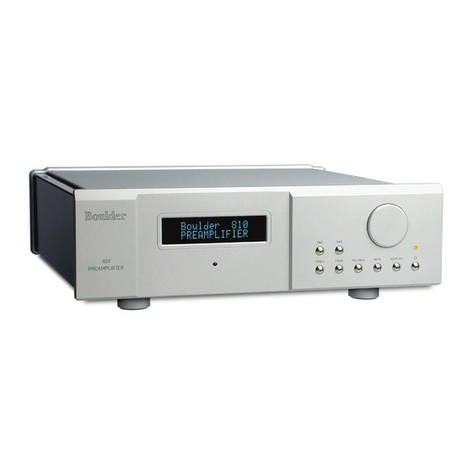
Boulder
Boulder 810 User manual

Boulder
Boulder Integrated Amplifier 865 User manual

Boulder
Boulder 3060 User manual
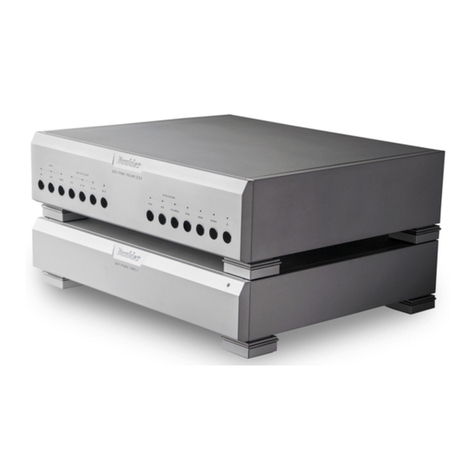
Boulder
Boulder 2108 User manual
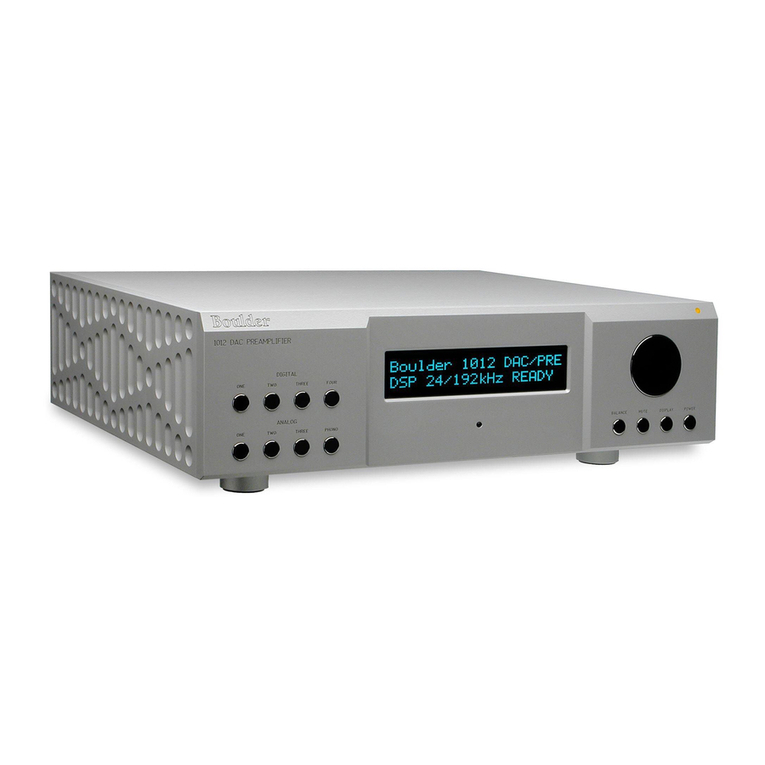
Boulder
Boulder 1012 DAC Preamplifier User manual
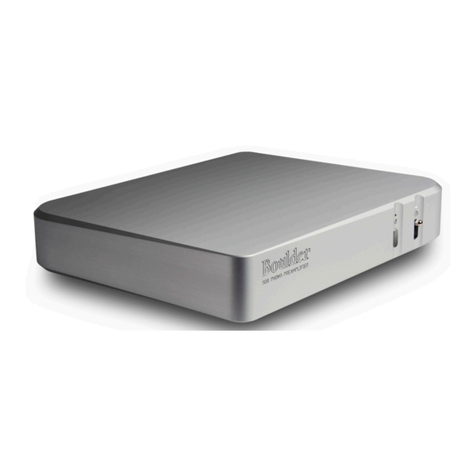
Boulder
Boulder 508 User manual
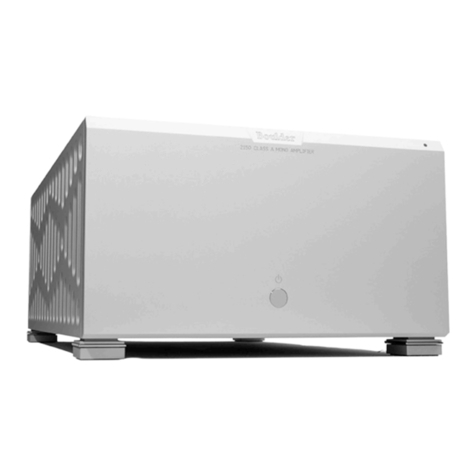
Boulder
Boulder 2150 User manual
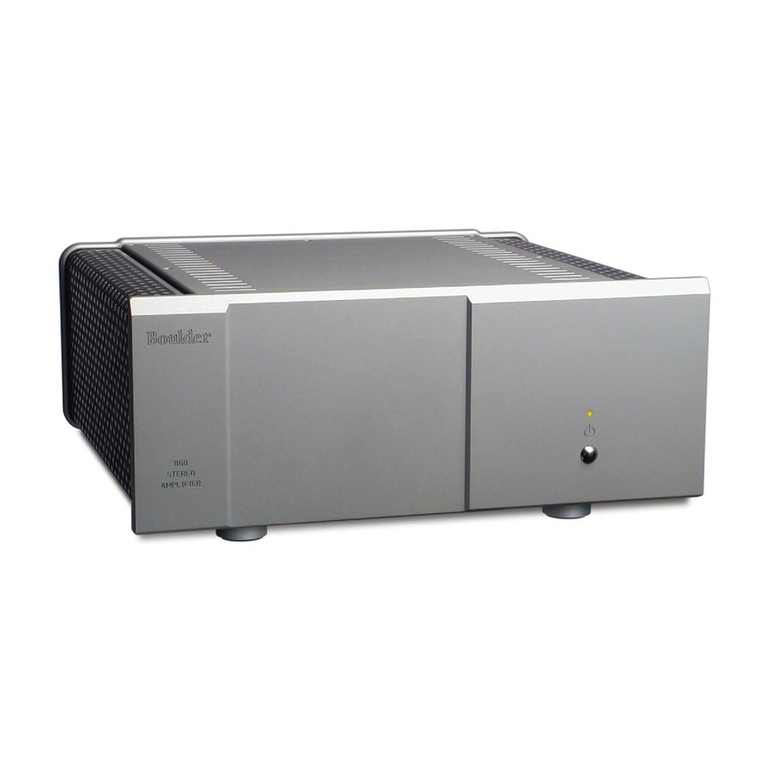
Boulder
Boulder 860 User manual

Boulder
Boulder 3050 User manual
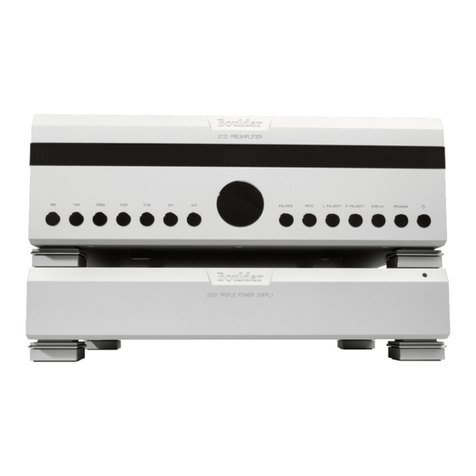
Boulder
Boulder 2110 User manual
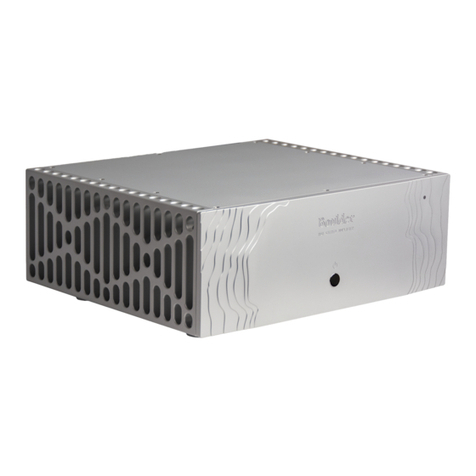
Boulder
Boulder 1161 User manual
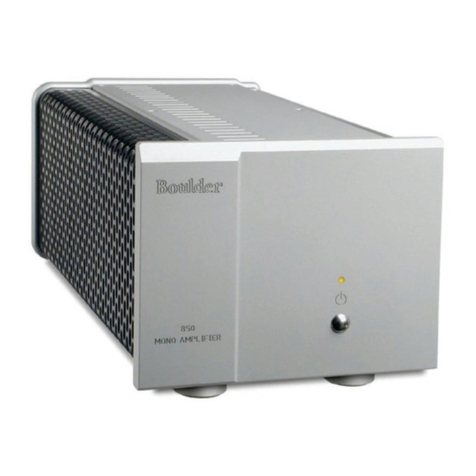
Boulder
Boulder 850 User manual
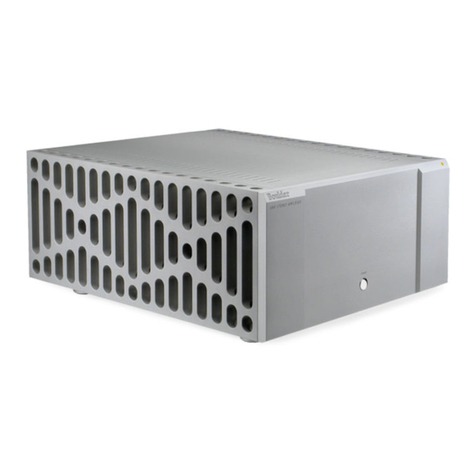
Boulder
Boulder 1060 User manual
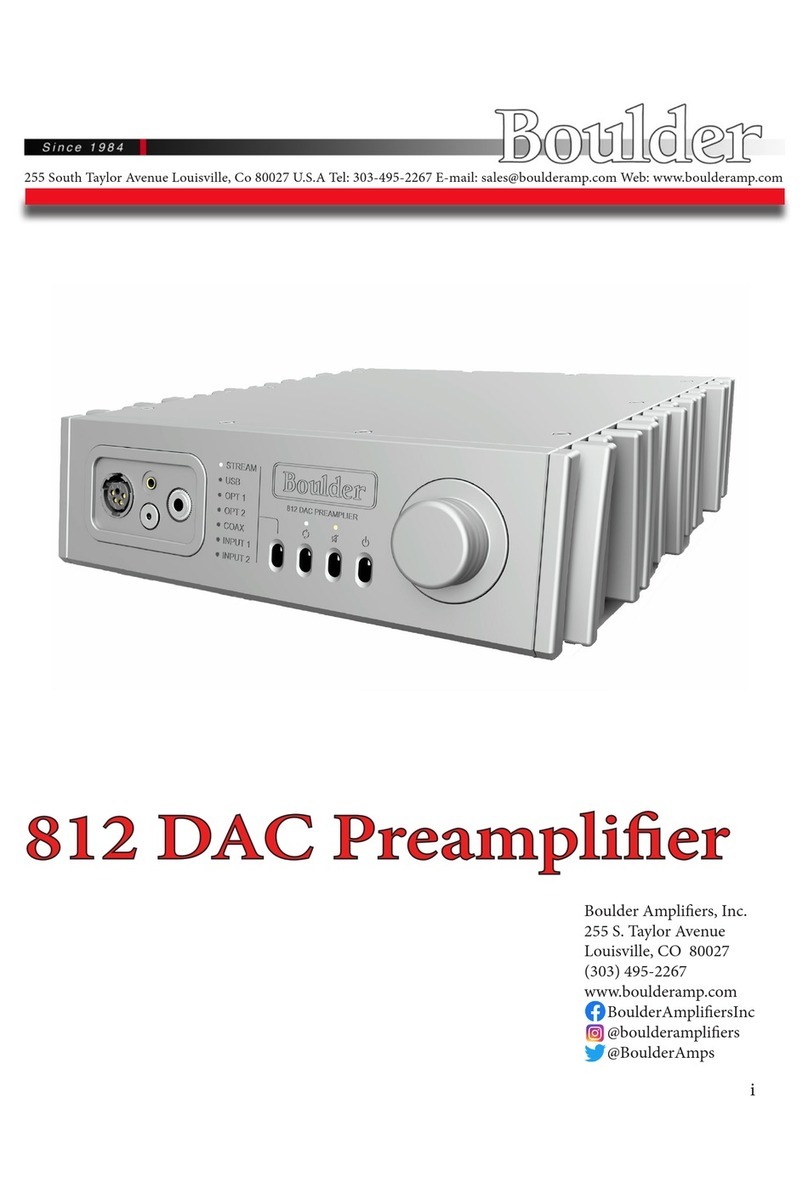
Boulder
Boulder 812 User manual

Boulder
Boulder 1108 User manual
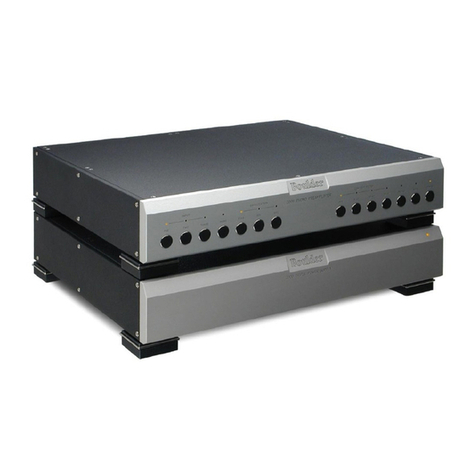
Boulder
Boulder 2008 User manual

Boulder
Boulder 1160 User manual
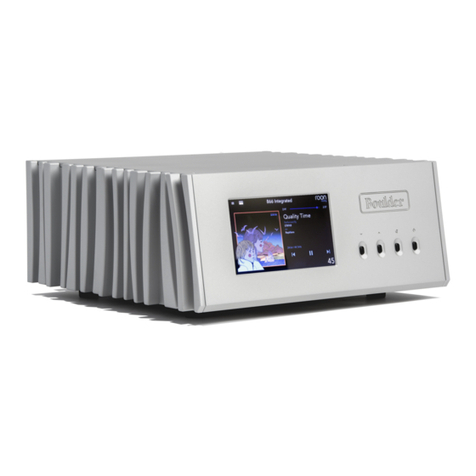
Boulder
Boulder 866 Analog User manual
